Xiaolu Zhang
EVOREFUSE: Evolutionary Prompt Optimization for Evaluation and Mitigation of LLM Over-Refusal to Pseudo-Malicious Instructions
May 29, 2025Abstract:Large language models (LLMs) frequently refuse to respond to pseudo-malicious instructions: semantically harmless input queries triggering unnecessary LLM refusals due to conservative safety alignment, significantly impairing user experience. Collecting such instructions is crucial for evaluating and mitigating over-refusals, but existing instruction curation methods, like manual creation or instruction rewriting, either lack scalability or fail to produce sufficiently diverse and effective refusal-inducing prompts. To address these limitations, we introduce EVOREFUSE, a prompt optimization approach that generates diverse pseudo-malicious instructions consistently eliciting confident refusals across LLMs. EVOREFUSE employs an evolutionary algorithm exploring the instruction space in more diverse directions than existing methods via mutation strategies and recombination, and iteratively evolves seed instructions to maximize evidence lower bound on LLM refusal probability. Using EVOREFUSE, we create two novel datasets: EVOREFUSE-TEST, a benchmark of 582 pseudo-malicious instructions that outperforms the next-best benchmark with 140.41% higher average refusal triggering rate across 9 LLMs, 34.86% greater lexical diversity, and 40.03% improved LLM response confidence scores; and EVOREFUSE-ALIGN, which provides 3,000 pseudo-malicious instructions with responses for supervised and preference-based alignment training. LLAMA3.1-8B-INSTRUCT supervisedly fine-tuned on EVOREFUSE-ALIGN achieves up to 14.31% fewer over-refusals than models trained on the second-best alignment dataset, without compromising safety. Our analysis with EVOREFUSE-TEST reveals models trigger over-refusals by overly focusing on sensitive keywords while ignoring broader context.
LLaDA 1.5: Variance-Reduced Preference Optimization for Large Language Diffusion Models
May 25, 2025Abstract:While Masked Diffusion Models (MDMs), such as LLaDA, present a promising paradigm for language modeling, there has been relatively little effort in aligning these models with human preferences via reinforcement learning. The challenge primarily arises from the high variance in Evidence Lower Bound (ELBO)-based likelihood estimates required for preference optimization. To address this issue, we propose Variance-Reduced Preference Optimization (VRPO), a framework that formally analyzes the variance of ELBO estimators and derives bounds on both the bias and variance of preference optimization gradients. Building on this theoretical foundation, we introduce unbiased variance reduction strategies, including optimal Monte Carlo budget allocation and antithetic sampling, that significantly improve the performance of MDM alignment. We demonstrate the effectiveness of VRPO by applying it to LLaDA, and the resulting model, LLaDA 1.5, outperforms its SFT-only predecessor consistently and significantly across mathematical (GSM8K +4.7), code (HumanEval +3.0, MBPP +1.8), and alignment benchmarks (IFEval +4.0, Arena-Hard +4.3). Furthermore, LLaDA 1.5 demonstrates a highly competitive mathematical performance compared to strong language MDMs and ARMs. Project page: https://ml-gsai.github.io/LLaDA-1.5-Demo/.
Understanding and Mitigating Overrefusal in LLMs from an Unveiling Perspective of Safety Decision Boundary
May 23, 2025Abstract:Large language models (LLMs) have demonstrated remarkable capabilities across a wide range of tasks, yet they often refuse to answer legitimate queries-a phenomenon known as overrefusal. Overrefusal typically stems from over-conservative safety alignment, causing models to treat many reasonable prompts as potentially risky. To systematically understand this issue, we probe and leverage the models'safety decision boundaries to analyze and mitigate overrefusal. Our findings reveal that overrefusal is closely tied to misalignment at these boundary regions, where models struggle to distinguish subtle differences between benign and harmful content. Building on these insights, we present RASS, an automated framework for prompt generation and selection that strategically targets overrefusal prompts near the safety boundary. By harnessing steering vectors in the representation space, RASS efficiently identifies and curates boundary-aligned prompts, enabling more effective and targeted mitigation of overrefusal. This approach not only provides a more precise and interpretable view of model safety decisions but also seamlessly extends to multilingual scenarios.We have explored the safety decision boundaries of various LLMs and construct the MORBench evaluation set to facilitate robust assessment of model safety and helpfulness across multiple languages. Code and datasets will be released at https://anonymous.4open.science/r/RASS-80D3.
LLaDA-V: Large Language Diffusion Models with Visual Instruction Tuning
May 22, 2025Abstract:In this work, we introduce LLaDA-V, a purely diffusion-based Multimodal Large Language Model (MLLM) that integrates visual instruction tuning with masked diffusion models, representing a departure from the autoregressive paradigms dominant in current multimodal approaches. Built upon LLaDA, a representative large language diffusion model, LLaDA-V incorporates a vision encoder and MLP connector that projects visual features into the language embedding space, enabling effective multimodal alignment. Our empirical investigation reveals several intriguing results: First, LLaDA-V demonstrates promising multimodal performance despite its language model being weaker on purely textual tasks than counterparts like LLaMA3-8B and Qwen2-7B. When trained on the same instruction data, LLaDA-V is highly competitive to LLaMA3-V across multimodal tasks with better data scalability. It also narrows the performance gap to Qwen2-VL, suggesting the effectiveness of its architecture for multimodal tasks. Second, LLaDA-V achieves state-of-the-art performance in multimodal understanding compared to existing hybrid autoregressive-diffusion and purely diffusion-based MLLMs. Our findings suggest that large language diffusion models show promise in multimodal contexts and warrant further investigation in future research. Project page and codes: https://ml-gsai.github.io/LLaDA-V-demo/.
Short-Path Prompting in LLMs: Analyzing Reasoning Instability and Solutions for Robust Performance
Apr 13, 2025Abstract:Recent years have witnessed significant progress in large language models' (LLMs) reasoning, which is largely due to the chain-of-thought (CoT) approaches, allowing models to generate intermediate reasoning steps before reaching the final answer. Building on these advances, state-of-the-art LLMs are instruction-tuned to provide long and detailed CoT pathways when responding to reasoning-related questions. However, human beings are naturally cognitive misers and will prompt language models to give rather short responses, thus raising a significant conflict with CoT reasoning. In this paper, we delve into how LLMs' reasoning performance changes when users provide short-path prompts. The results and analysis reveal that language models can reason effectively and robustly without explicit CoT prompts, while under short-path prompting, LLMs' reasoning ability drops significantly and becomes unstable, even on grade-school problems. To address this issue, we propose two approaches: an instruction-guided approach and a fine-tuning approach, both designed to effectively manage the conflict. Experimental results show that both methods achieve high accuracy, providing insights into the trade-off between instruction adherence and reasoning accuracy in current models.
Effective and Efficient Masked Image Generation Models
Mar 10, 2025Abstract:Although masked image generation models and masked diffusion models are designed with different motivations and objectives, we observe that they can be unified within a single framework. Building upon this insight, we carefully explore the design space of training and sampling, identifying key factors that contribute to both performance and efficiency. Based on the improvements observed during this exploration, we develop our model, referred to as eMIGM. Empirically, eMIGM demonstrates strong performance on ImageNet generation, as measured by Fr\'echet Inception Distance (FID). In particular, on ImageNet 256x256, with similar number of function evaluations (NFEs) and model parameters, eMIGM outperforms the seminal VAR. Moreover, as NFE and model parameters increase, eMIGM achieves performance comparable to the state-of-the-art continuous diffusion models while requiring less than 40% of the NFE. Additionally, on ImageNet 512x512, with only about 60% of the NFE, eMIGM outperforms the state-of-the-art continuous diffusion models.
Every FLOP Counts: Scaling a 300B Mixture-of-Experts LING LLM without Premium GPUs
Mar 07, 2025



Abstract:In this technical report, we tackle the challenges of training large-scale Mixture of Experts (MoE) models, focusing on overcoming cost inefficiency and resource limitations prevalent in such systems. To address these issues, we present two differently sized MoE large language models (LLMs), namely Ling-Lite and Ling-Plus (referred to as "Bailing" in Chinese, spelled B\v{a}il\'ing in Pinyin). Ling-Lite contains 16.8 billion parameters with 2.75 billion activated parameters, while Ling-Plus boasts 290 billion parameters with 28.8 billion activated parameters. Both models exhibit comparable performance to leading industry benchmarks. This report offers actionable insights to improve the efficiency and accessibility of AI development in resource-constrained settings, promoting more scalable and sustainable technologies. Specifically, to reduce training costs for large-scale MoE models, we propose innovative methods for (1) optimization of model architecture and training processes, (2) refinement of training anomaly handling, and (3) enhancement of model evaluation efficiency. Additionally, leveraging high-quality data generated from knowledge graphs, our models demonstrate superior capabilities in tool use compared to other models. Ultimately, our experimental findings demonstrate that a 300B MoE LLM can be effectively trained on lower-performance devices while achieving comparable performance to models of a similar scale, including dense and MoE models. Compared to high-performance devices, utilizing a lower-specification hardware system during the pre-training phase demonstrates significant cost savings, reducing computing costs by approximately 20%. The models can be accessed at https://huggingface.co/inclusionAI.
Keypoint-based Progressive Chain-of-Thought Distillation for LLMs
May 25, 2024



Abstract:Chain-of-thought distillation is a powerful technique for transferring reasoning abilities from large language models (LLMs) to smaller student models. Previous methods typically require the student to mimic the step-by-step rationale produced by LLMs, often facing the following challenges: (i) Tokens within a rationale vary in significance, and treating them equally may fail to accurately mimic keypoint tokens, leading to reasoning errors. (ii) They usually distill knowledge by consistently predicting all the steps in a rationale, which falls short in distinguishing the learning order of step generation. This diverges from the human cognitive progression of starting with easy tasks and advancing to harder ones, resulting in sub-optimal outcomes. To this end, we propose a unified framework, called KPOD, to address these issues. Specifically, we propose a token weighting module utilizing mask learning to encourage accurate mimicry of keypoint tokens by the student during distillation. Besides, we develop an in-rationale progressive distillation strategy, starting with training the student to generate the final reasoning steps and gradually extending to cover the entire rationale. To accomplish this, a weighted token generation loss is proposed to assess step reasoning difficulty, and a value function is devised to schedule the progressive distillation by considering both step difficulty and question diversity. Extensive experiments on four reasoning benchmarks illustrate our KPOD outperforms previous methods by a large margin.
Unifying Bayesian Flow Networks and Diffusion Models through Stochastic Differential Equations
Apr 24, 2024
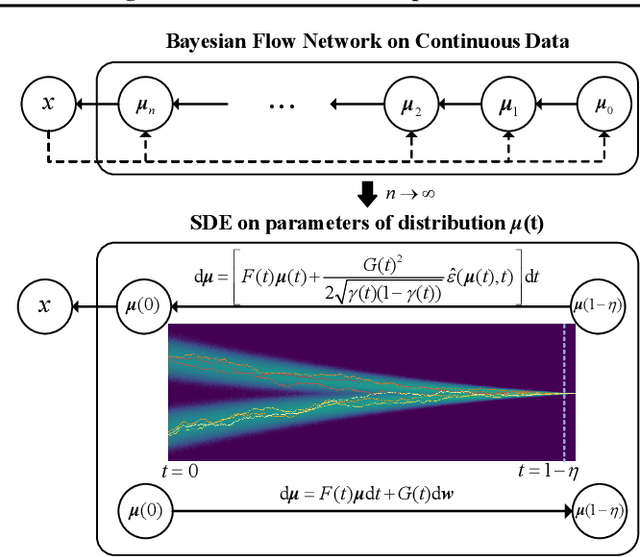
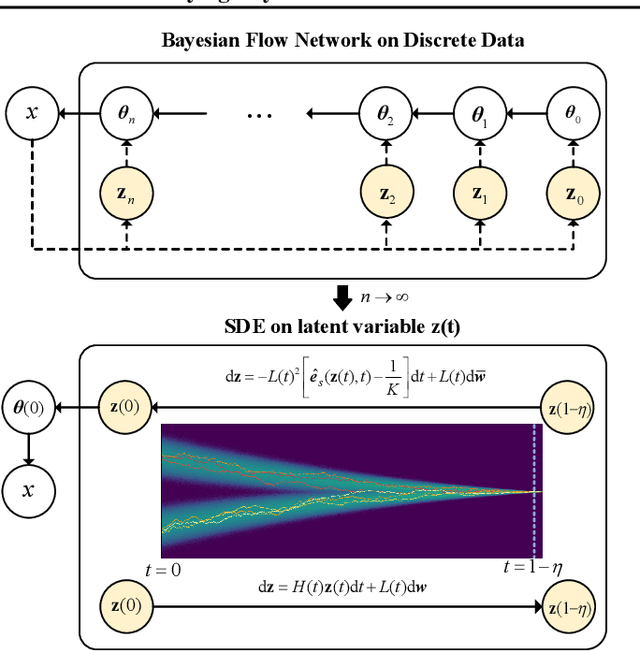

Abstract:Bayesian flow networks (BFNs) iteratively refine the parameters, instead of the samples in diffusion models (DMs), of distributions at various noise levels through Bayesian inference. Owing to its differentiable nature, BFNs are promising in modeling both continuous and discrete data, while simultaneously maintaining fast sampling capabilities. This paper aims to understand and enhance BFNs by connecting them with DMs through stochastic differential equations (SDEs). We identify the linear SDEs corresponding to the noise-addition processes in BFNs, demonstrate that BFN's regression losses are aligned with denoise score matching, and validate the sampler in BFN as a first-order solver for the respective reverse-time SDE. Based on these findings and existing recipes of fast sampling in DMs, we propose specialized solvers for BFNs that markedly surpass the original BFN sampler in terms of sample quality with a limited number of function evaluations (e.g., 10) on both image and text datasets. Notably, our best sampler achieves an increase in speed of 5~20 times for free. Our code is available at https://github.com/ML-GSAI/BFN-Solver.
AntDT: A Self-Adaptive Distributed Training Framework for Leader and Straggler Nodes
Apr 15, 2024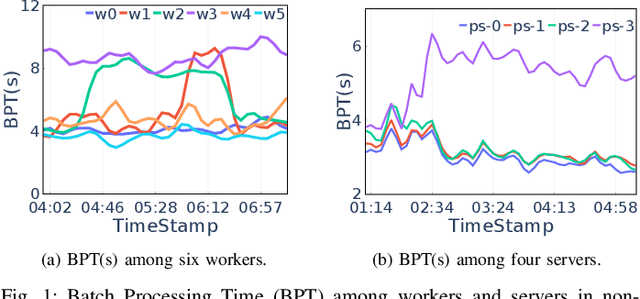
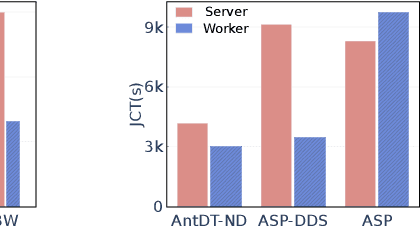
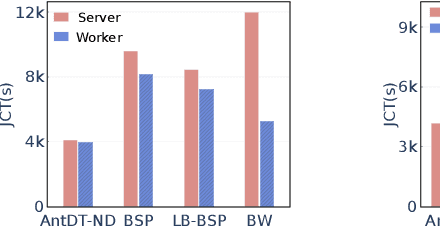
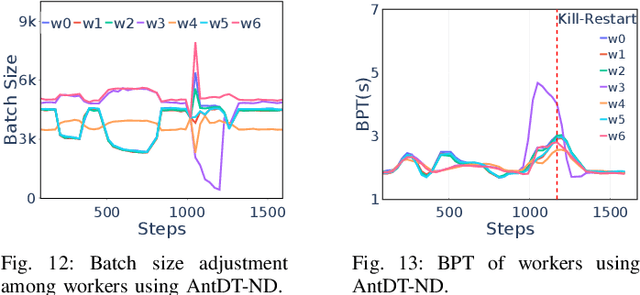
Abstract:Many distributed training techniques like Parameter Server and AllReduce have been proposed to take advantage of the increasingly large data and rich features. However, stragglers frequently occur in distributed training due to resource contention and hardware heterogeneity, which significantly hampers the training efficiency. Previous works only address part of the stragglers and could not adaptively solve various stragglers in practice. Additionally, it is challenging to use a systematic framework to address all stragglers because different stragglers require diverse data allocation and fault-tolerance mechanisms. Therefore, this paper proposes a unified distributed training framework called AntDT (Ant Distributed Training Framework) to adaptively solve the straggler problems. Firstly, the framework consists of four components, including the Stateful Dynamic Data Sharding service, Monitor, Controller, and Agent. These components work collaboratively to efficiently distribute workloads and provide a range of pre-defined straggler mitigation methods with fault tolerance, thereby hiding messy details of data allocation and fault handling. Secondly, the framework provides a high degree of flexibility, allowing for the customization of straggler mitigation solutions based on the specific circumstances of the cluster. Leveraging this flexibility, we introduce two straggler mitigation solutions, namely AntDT-ND for non-dedicated clusters and AntDT-DD for dedicated clusters, as practical examples to resolve various types of stragglers at Ant Group. Justified by our comprehensive experiments and industrial deployment statistics, AntDT outperforms other SOTA methods more than 3x in terms of training efficiency. Additionally, in Alipay's homepage recommendation scenario, using AntDT reduces the training duration of the ranking model from 27.8 hours to just 5.4 hours.
 Add to Chrome
Add to Chrome Add to Firefox
Add to Firefox Add to Edge
Add to Edge